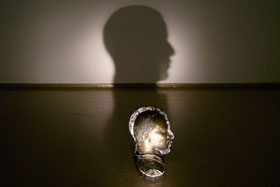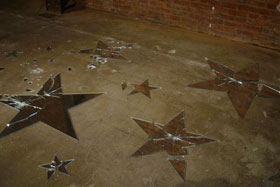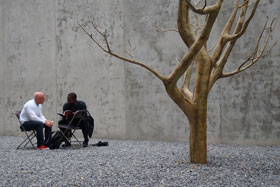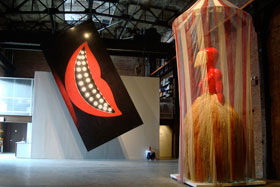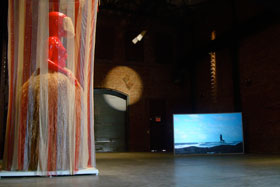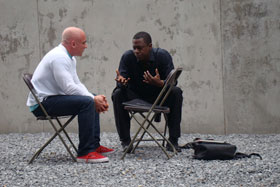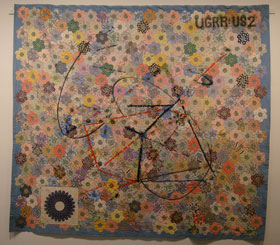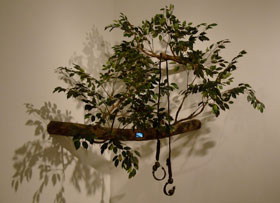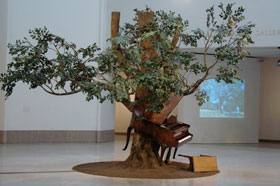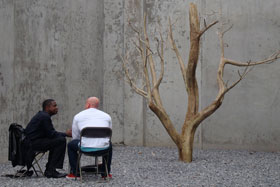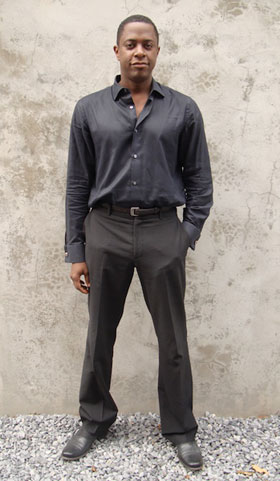|
|||||||||||||
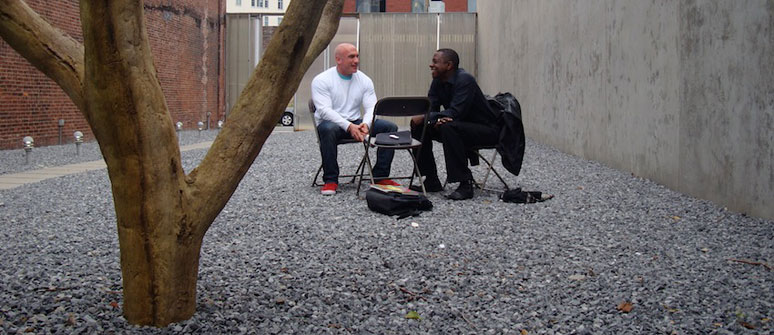 |
|||||||||||||
| Batalla y Biggers. Foto: Dany Barreto | |||||||||||||
Veo tus muestras y me parece que tu trabajo incluye muchos elementos codificados en referencia a la cultura afroamericana. Quizá algunos de sus significados se pierdan dependiendo donde se exhiba.
Un show en Norteamérica va a ser leído de cierta forma. Y algunas de estas obras fueron exhibidas en otros países y se leen muy distinto. Lo hago conscientemente, porque las historias cambian cuando viajamos. Otra de las grandes influencias en mi obra viene del budismo, viví en Japón 3 años y fui marcado por el budismo como religión, por supuesto, pero también como filosofía, aprendí de ella muchas cosas que forman parte de mi trabajo. Tanto en esta muestra como en la de Brooklyn, mi utilización del árbol se da desde una mirada budista y luego va hacia otras culturas, abarca más capas de definiciones. También mi proceso de trabajo deriva mucho de la improvisación y la espontaneidad, así que trato de estar muy tranquilo en el momento de hacer una pieza para que lo que me influye emerja. Trato de no predeterminar demasiado, me gusta que fluya. Creo que eso también viene de los años de estudiar budismo. Y, aunque me refiero a muchos temas norteamericanos y afroamericanos, creo que el contexto juega un papel importante. Hablás de budismo. Y me hace pensar en la relación fuerte con el deseo que sostienen tanto la cultura norteamericana como la africana. Que el budismo niega y ve desde un punto de vista opuesto. ¿Cómo manejás eso? ¿Cuál es tu relación con el deseo?
Ese es un punto interesante. Respecto al deseo, veo a EEUU en un extremo, a Oriente en el otro y a África en algún punto intermedio. Japón tiene, como se sabe, democracia capitalista; pero el budismo trata, desde luego, acerca del no deseo y el desapego. Y esa es otra de las ideas que posibilitó que yo sea un artista. Llevo tiempo trabajando, pero nunca pienso en el resultado. Y mi deseo está solo motorizado por aquello que es me es posible hacer en un momento dado. Entonces, en vez de aspirar a realizar algo que todavía no puedo, pienso en mis recursos y trato de hacer algo con ellos. Pero el deseo americano está siempre en algún lugar a mi espalda, mirando alrededor, tratando de asomar su cabeza. Trato de neutralizarlo lo máximo posible. Y el deseo moviliza al arte contemporáneo, en cierto modo. Nos movemos a través de él.
Pienso que usamos al deseo para seducir y hacer que la gente se interese en lo que estamos mostrando o en aquello de lo que hablamos, según sea un objeto o un concepto. Así que, aunque extingamos el deseo en nosotros mismos, debemos promoverlo hasta cierto punto en los demás porque hacemos arte, que es un fenómeno sensorial.
En pocas palabras, ¿cuál es tu opinión sobre la circunstancia presente del arte?
Creo que es un momento excitante. Si me hubieses preguntado cinco años atrás, pienso que no lo era tanto. Pasaron muchas cosas y el arte vive un mundo nuevo, tanto desde el ángulo comercial como desde el no comercial. Hemos atravesado las primeras instancias del multiculturalismo, que abrió mucho, tuvo sus cosas positivas y negativas. Ha habido una gigantesca transformación y las cosas no van a volver a ser como eran. Probablemente todo seguirá creciendo, pero también veo ahora que los artistas están tan absorbidos por las ventas y el marketing, que sería buenísimo si se pusieran de vuelta a trabajar, a hacer cosas nuevas, diferentes, riesgosas. Me parece que el hecho de que vos y yo podamos estar acá sosteniendo esta conversación es algo que no habría sucedido tan fácilmente 5 o 10 años atrás. Esta especie de fluidez y accesibilidad que los artistas tenemos entre nosotros, internacionalmente, eso es increíble.
Ok, sé que el hip hop es fuerte para vos. ¿Qué quiere decir el hip hop? Estoy seguro de que nosotros en Latinoamérica hacemos una lectura muy diferente de él.
Pienso que en verdad el hip hop va acerca de una energía, y es un fenómeno cultural con el que trabajo desde sus inicios y que ahora veo cómo pasó a ser un fenómeno internacional. Si voy a Sudamérica o a Europa del Este, me encuentro un hip hop como el que veía aquí 20 años atrás. Muy político, y aun auténtico como forma artística y de comunicación. Del modo que lo veo actualmente en EEUU es transformado en cultura pop. Otra cosa que antes. Eso aun está, la forma original sigue pero es under. Aunque creo que como operación cultural ha abierto muchas puertas y ha hecho a la cultura negra una cultura para todos. Cuando surgió era casi como una forma secreta de los negros y latinos de hablarse directamente unos a otros, pero ahora se ha vuelto un fenómeno. Para mí aun se trata de la energía, que viene del punk, del jazz y de músicas de frontera que buscan unirse y quitar barreras. Decíamos de la improvisación, y es enorme en el hip hop. Me gusta usarlo como filosofía dentro de mi trabajo. Aunque no diga "hip hop" o utilice una canción como referencia, es una energía que está incorporada.
Hablando de música, tu muestra me recordó las experimentaciones de Fluxus y Dada. ¿Te interesan?
Absolutamente. En verdad pienso que no hay demasiadas diferencias en ciertos trabajos. Esos movimientos a cierto nivel son irreverentes respecto a lo que ha sucedido antes, tratan de romper paredes. Y volvemos a la espontaneidad y la improvisación, y a una mentalidad D.R.Y. (don´t repeat yourself- no te repitas).
A lo mejor esa espontaneidad que perseguís encuentra espacio más adecuado en muestras institucionales como las que estás presentando ahora que en galerías. Pero, ¿puede un artista contemporáneo pasar de las galerías?
Los artistas sabemos que hay diferentes modos de lograr que las cosas sucedan. No hay un solo camino específico. Como educador, nunca doy consejos enfáticos acerca de cómo ser un artista. Todos tenemos un camino individual, mis estudiantes tienen que encontrar el propio. Les corresponde a los artistas descubrir qué funciona mejor para ellos. No dependemos de las galerías, pero estas tienen un rol importante en todo el sistema. Muchos artistas del pasado dependieron de las galerías para lograrlo todo. Pero con la tecnología, la comunicación, el acceso a internet, los artistas pueden lograr por sí mismos que sucedan muchas cosas. Lo que vuelve a la relación con las galerías posible de saltear. Un poco.
Llamás a tu show del Museo de Brooklyn "una introspectiva". ¿Porqué ese título? Me gusta.
Me parece que llamarlo "retrospectiva" era prematuro. Lo de "introspectiva" tiene mucho más sentido. Pone una suerte de foco; una introspección en mi proceso, mis ideas, mi trabajo.
Ahora te confieso que me provocaba curiosidad ver cómo tendrías el pelo hoy. Sé que es un tema para vos. Vi el video que muestra cómo te cortaron tus dreadlocks.
Tuve dreadlocks dos veces en mi vida, la primera durante cinco años, la segunda durante nueve. Pero llegó un momento en que ya no quiero más ser identificado con una sola cosa, que es algo que no se puede controlar. No quiero esa identificación rápida. Me encantan los locks, me parecen bellos, pero mi tiempo de tenerlos propiamente pasó, al menos por el momento. Quiero ser más despojado. Personal, espiritual y visualmente. Hay un video en mi web sobre una performance que hice en Japón, en la cual me corté el pelo en una ceremonia. Fue en 2004, y estaba sentado en el bosque, usando un kimono, en meditación, y entonces una amiga llegó por detrás y cortó cada uno de mis dreadlocks. Y esa fue la última vez que los tuve.
Antes que llegases estaba viendo el video, al hombre con los dreadlocks que es el protagonista, y de algún modo me sorprendí cuando entraste y vos no eras él.
Es mi amigo Ricardo.
Pero ahí funciona como tu alter ego.
Eso está bueno. Mirá, en los vídeos y performances trato de no incluirme demasiado a mí mismo. Aparezco en dos vídeos, pero en ellos soy solamente un cuerpo negro. Un arquetipo. En estos vídeos, Ricardo también aparece como arquetipo. Y no un arquetipo afroamericano, sino como arquetipo de la diáspora. Y en el proceso de poner y quitarse el maquillaje, transformándose en un ser de género indeterminado, se vuelve un arquetipo para todos. Ese es el objetivo. No ves más los dreadlocks, ahora ves al payaso, al extraño. Y supongo que en la próxima parte del video el personaje va a desaparecer completamente como entidad física, se va a volver un espíritu.
Esto conecta con la idea de Post-Black. Fuiste parte de una exhibición emblemática dedicada a desarrollarla.
Sí, fue Freestyle, curada por Thelma Golden en el Studio Museum de Harlem. Planteaba la aparición de una generación de artistas negros que estaba haciendo un trabajo diferente y tratando otras temáticas que generaciones anteriores. El término "arte negro" le ha dado a los negros orgullo, pero al mismo tiempo los ha apartado del mundo del arte mainstream; porque es "arte negro", no "arte". Así que Post-Black fue un camino para salirse de ahí. Mi problema con ello es que "negro" aun está en el título. Pero aquí estamos, pasaron varios años desde esa muestra. Y creo que la frase funcionó muy bien en el mundo del arte, y que abrió las compuertas para que entrasen toneladas de artistas y hablasen de cualquier cosa que tuviesen ganas de hablar. Lo que es extremadamente liberador. Pero ahora pienso en el término Post-Black en relación a la cultura y sociedad norteamericanas y me siento más lejos de esa relación. Antes, debías encajar en una caja. Ahora no hay más caja. Creo que este movimiento a través del desarrollo de arte e ideas ha penetrado en la cultura, y es genial haber sido parte de eso, y ver cómo sucedió. Veo cómo cambian las cosas todo el tiempo. Ahora imagino lo que vendrá en siete u ocho años más y pienso que es un momento culturalmente increíble.
Y ahora, ¿hacía dónde te dirigís?
Creo que mi posición está resumida en el lugar que se encuentra el personaje del video: mirando hacia el océano, de algún modo diciéndose "vení océano y llevame, ¿cuál será el próximo viaje?". Me siento al borde del precipicio y a punto de saltar. In the edge of a precipice, about to jump inSanford Biggers: Conversation at the Sculpture CenterVisiting your exhibitions, I guess your work includes many encoded elements referred to African American culture. Maybe some of its meaning will get lost, depending on where it is exhibited.
A show in America will be read in a certain way. But some of this pieces have been shown as well in other countries and they read very differently. And I consciously do that, because histories change as we travelI . Some other major influence in my work comes from Buddhism, you know I lived in Japan for 3 years and was influenced by Buddhism as a religion of course but as a philosophy as well, there are many things I learned there that take part into my work. At the Brooklyn show and even here, my use of the tree really starts with the Buddhist standpoint and then goes to other cultures, to more layered definitions. Also my process in work is much derived from improvisation, spontaneity, so I try to be very quiet at the moment of making a piece so many influences show up. I try not to be too predetermined, I like that there´d be some flow. I guess, that also comes from studying buddhism for years. And, also I reference a lot of American and Afroamerican issues, I think context plays a big part. You talked about Buddhism. And it makes me think that both NorthAmerican and African culture have a strong relationship with desire. Which Buddhism denies, and sees it from an opposite point of view. How do you handle that? What´s your relationship with desire?
That´s an interesting point. Respect to this, I somehow see America in one extreme, Orient in the other, and Africa somewhere between. Japan is, you know, capitalist democracy. But buddhism of course is about no desire and no attachment. And that´s another one of the ideas that have made it possible to be an artist for me. Because I know I´ve been working for a while and have never done work thinking about the outcome. And my desire is fueled only by what I can possibly do at any given time. So, instead of wishing to do something that I can´t yet, I think of what I have as my resources and try to make something with that. But America´s desire is always somewhere on the back, looking around, trying to pick its head out. I try to mediate that as much as possible. And I guess that contemporary art is moved by desire in a way. We move through it.
I think that we bring desire to seduce and make people get interested in what we are showing or talking about, either it´s an object or a concept. So I think even if we shut desire for ourselves, we also promote desire to some degree because we make art, that is a sensorial phenomena.
In a few words, what is your opinion about this present moment in contemporary arts?
I´m actually very excited right now. If you asked me five years ago, I was not as excited. I think lots of things have happened, and that we live in a new art world, both from the commercial and the uncommercial sides. I think we went through the initial stages of multiculturalism, which opened up some things, it had some positives and negatives. I think we have gone through a huge art transformation and things will never be as they used to. Things will probably increasingly grow, but I also see right now that artists are so preoccupied with just selling and just marketing, and that it would be great if more of them go back to work, to do new, different or risky things. And I think the fact that you and I can have this conversation is something it would not have happened so easily 5 or 10 years ago. I think this kind of fluidity and access that artists have between each other, internationally, is incredible.
Ok, I know hip hop is strong for you. What does hip hop mean? I´m sure in Latin America hip hop is read as something very different.
I think ultimately hip hop becomes about an energy, and a cultural phenomenon that I work with from the early stages to now see it as an international phenomenon. And as you mentioned, if I go to South America or to Eastern Europe i see hip hop the way I saw it 20 years ago. Very political, and still rooted as a type of communication and art form. And the way I see it today in the US is that it has become basically Pop culture. Not the same thing as was when I was growing up. It´s still out there, that kind of original form is still there but it´ s underground. But the way I see it coming to art and actually to culture is that has opened many doors and has made Black culture everybody´s culture. When it first came out it was almost a secret way of black and latinos talking directly to one another, but now since it has grown to a phenomenon. For me it´s still about the energy, which comes from punk, from jazz and from frontier musics that look to blend and to strip down barriers. We spoke about improvisation, and it´s huge in hip hop. I like to use that as a philosophy in the work, even is it doesn´t say "hip hop", or reference a song, it´s still that energy that goes into the work.
Coming to music, your show pretty much reminded me of Fluxus and Dada experiments. Are you interested in them?
Absolutely. I actually think there´s no so much difference in some works. Those movements at certain levels are irreverent respect to what happened before, they try to break walls. And it comes again to spontaneity and improvisation, and a D.R.Y. (don´t repeat yourself) mindset.
Perhaps that spontaneity you look for also finds better room in institutional shows as the ones you are presenting now than in art galleries. But, can a contemporary artist surf across the galleries issue?
We all artists know that there are many ways to make the things happen, there is no one specific path. As an educator, I never make strong suggestions on how to go to become an artist. Everybody has an individual path, my students have to find their own. I think is up to artists to figure out what works best for them. i think you are not beholding to galleries, but galleries do serve in an important time in the whole system. Many artists in the past have relied on galleries to make everything happen. And, you know, with technology, communication, internet access, artists can make a lot of things happen on their own. Which makes their relationship with galleries perhaps possible to shift a little bit.
You call your Brooklyn show "an introspective". Why that title? I like it.
I think to call it a retrospective was premature, I think to call it an introspective has much more sense. It puts a sort of focus, an introspection on my process, my ideas, my work.
Now I must confess I was curious to see how you carried your hair these days. I know it is a subject in itself for you. I am familiar with the video that shows how once you got to cut your dreadlocks.
I had dreadlocks twice in my life, first time for 5 years, next time for 9 years. But it comes to a moment in which I no longer want to be identified as one thing, and you can´t control that. I want to shed that quick identification. I love locks, I find them beautiful, but I think my time has properly passed, at least for the moment. And I want to be more stripped down. Personally, spiritually and visually. I made the video that´s in my web of a performance I did in Japan in which I cut my hair in a ceremony. It was 2004, and I was sitting in the woods, wearing a kimono, in meditation, and then a friend comes from behind and cuts each one of my locks. And that was the last time I had locks.
Before you came in I was watching the video, the guy with the locks who is the protagonist, and somehow it shocked me when you came in and weren´t him.
That is my friend Ricardo.
But there he functions as your alter ego. That is fine, let it go. See, in video and performance I try not to include myself that much. I´ve been in two, but it is just a black body. When I use my body in performance I use it as an archetype. For the videos, Ricardo is standing for an archetype. But not a black American archetype, he is a diasporic archetype. And in the process of putting the makeup and taking the makeup off, changing into a non-specific gender being, he becomes an archetype for everyone. That´s the goal. You don´t see anymore the dreadlocks, now you see the clown, the alien. And I assume that in the next part of the video he will disappear as a physical entity completely, and he will become a spirit.
That connects with the idea of Post-Black. There was an emblematic exhibition oriented to its development in which you took part.
Yes, you talk about the Freestyle exhibition at the Studio Museum of Harlem, curated by Thelma Golden. They were setting the stage for artists of my generation who are not necessarily making the same work or dealing with the same issues that previous generations were. And the term "black art" on some level has given black people pride but at the same time has gotten them apart from the mainstream art world, because you know, it is black art, it is not art. So Post Black was a way of divorcing that legacy. My problem with the term is that "black" is still on the title. But here we are, a few years have passed since that exhibition. And I think as a soundbite it was great in the art world, and I think it opened up floodgates for tons of artists to come through and speak about anything they wanted to talk about. Which is extremely liberating. But now I am looking at the term Post Black as it relates to culture and society in America and I find more apart from that relationship. Before, you had to fit into the box. Now there is no more box. I think through art and ideas that movement has permeated culture and it´s amazing to have been part of that, and see all those things happen. I see things changing all the time. Now I guess what will come in seven or eight more years, I think it is an incredible cultural moment.
Where are you heading to?
I think my work is pretty much summed up where is that character from the video, overlooking the ocean, sort of wandering "come the ocean and take me in, what´s the next journey?". I feel I am in the precipice about to jump in. |
|||||||||||||
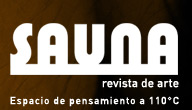 |
|||||||||||||||||||||||||||||||||||||||||||||||||||||||||||||||||||||||||||||||||||||||||||||||||||||||||||||||||||||||||||||||||||||||||||||||||||||||||||||||||||||||||||||||||||||||||||||||||||||||||||||||||||||||||||||||||
|
